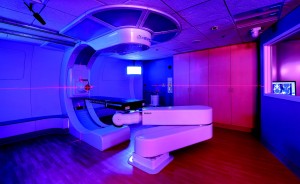Greater Orlando’s Healthy Future
Medical advancements available at local hospitals open a world of exciting possibilities.
We live in an age of miracles—particularly when it comes to medical advancements. Each day seems to bring new technology, new treatments and new ways of thinking designed not just to improve our quality of care, but to help us enjoy longer, healthier and happier lives. Better still, Greater Orlando residents have access to many of the latest treatments and medical possibilities, as well as an array of highly qualified doctors to enact them.
To find out what’s new in the world of medicine, we caught up with some of the area’s most pioneering physicians and asked them about the latest innovations in their fields of expertise. What they have to say might not just amaze you, but even leave you looking forward to your next visit to the doctor.
Healing Power of Protons
In April, Orlando Health opened the Marjorie and Leonard Williams Center for Proton Therapy, which is the first facility in Central Florida to offer state-of-the-art proton options for patients battling cancer. In layman’s terms, proton therapy is similar to radiation treatment, but it targets selected tumors with pinpoint accuracy.
As Dr. Naren Ramakrishna, the director of neurologic and pediatric radiation oncology at UF Health Cancer Center—Orlando Health, explains, proton therapy uses charged particles called protons to deliver a dose directly to a targeted tumor while sparing the surrounding normal organs and tissues. “What it amounts to,” says Dr. Ramakrishna, “is you can have a lot less side effect from proton therapy in select cases.”
Modern proton therapy is such a relatively recent development that there are only three such treatment centers in Florida, with the other two being located in Jacksonville. As a partial result of that novelty, use of proton therapy hasn’t been expanded to treat all types of cancer yet, but Orlando Health’s physicians have begun to use it for some common forms. They’ve also found it to be very useful for pediatric patients, whose growing bodies are more sensitive to radiation.
“Our first pediatric case was a young man with a tumor that involved the brain and spine, so we ended up treating the entire brain and spine,” says Dr. Ramakrishna, adding that the patient is doing extremely well. “We’re very excited about the types of cases we’re treating with proton therapy. It’s really making a big difference for the patient.”
ROSA the Robot
Fans of science fiction have long dreamed of being treated by robot doctors. That dream hasn’t been fulfilled just yet, but robots are increasingly showing up in medical environments—including the ROSA robotic arm device used by Dr. Ki Hyeong Lee, the medical director of Florida Hospital for Children’s Comprehensive Pediatric Epilepsy Center.
“The device is basically a robot,” says Dr. Lee, who adds that ROSA is employed when a doctor needs to put electrodes in deep, difficult-to-reach locations inside the brain. “With conventional surgery, we can place electrodes anywhere we can see, but trying to put electrodes where we cannot see involves a lot of guessing and a lot of difficulty accessing the deep areas.”
ROSA replaces guesswork with planning and targeting precision. After receiving a patient’s MRI results via a USB drive, ROSA is able to pinpoint the exact spot to drill the hole and place the electrodes, eliminating the highly invasive craniotomy required by conventional methods. Instead, a very small hole, approximately 2.4 millimeters wide, is all that’s needed. “We can do it in a much shorter amount of time, and also we can be very accurate where we target,” says Dr. Lee. “I think that’s a beauty.”
Accordingly, ROSA gives surgical options to patients who might have avoided such a course due to the associated risks and inconveniences, including a recent patient who was suffering from seizures caused by a tumor in his left temporal lobe. “In the past to take out this tumor, we would’ve approached with conventional surgery,” says Dr. Lee. “With this ROSA technique, we’re able to place electrodes right into the tumor.”
Fighting Childhood Liver Disease
As awful as undergoing a liver biopsy can be for adults, such procedures—and their inherent risks—are even worse for children, but a new imaging technique being used at Nemours Children’s Hospital is helping kids avoid that experience. Called magnetic resonance (MR) elastography, the procedure allows for earlier, safer and more precise diagnosis and monitoring for children with chronic liver disease, to the benefit of patients and their families.
Most cases of chronic liver disease in children occur when the body deposits fat in the liver, which can cause it to become inflamed. Left untreated, this inflammation can lead to hepatic fibrosis or even cirrhosis, creating a heightened risk of liver cancer. Nemours is actually the first pediatric provider in Central Florida to use this technique, and they note that the number of necessary and invasive liver biopsies has declined dramatically at other children’s hospitals that have adopted the same method.
MR elastography uses low-frequency waves in combination with magnetic resonance imaging (MRI) to measure liver stiffness in a non-invasive, painless manner free of ionizing radiation. Even if a liver biopsy is eventually required, this exam helps doctors better target the appropriate area of the liver.
“Nemours is committed to using state-ofthe- art imaging technology to minimize risk, improve outcomes and increase value for our patient families,” says Dr. Daniel J. Podberesky, radiologist-in-chief for Nemours Children’s Health System. “MR elastography is truly an improvement over how doctors have historically assessed chronic liver disease.”
Making Tumors Glow
Removing tumors has always been a tricky business—particularly when it comes to irregularly shaped tumors that can be difficult to remove fully and pose more risk to patients. To overcome that challenge, Florida Hospital surgeons have begun using a Zeiss Pentero 900 surgical microscope in conjunction with a special sodium fluorescein filter to target brain tumors, and they’re having great success with the relatively new procedure.
“We call it ‘making the tumor glow,’” says neurosurgeon Dr. Ravi H. Gandhi, noting that the microscope and special filter make it possible to see an entire tumor under fluorescents. “This technology enables us to see the tumor separate from normal brain while we’re actually taking it out.
“It’s interesting technology, and the beauty of it is that it’s actually quite simple. If you can see the tumor, and the tumor is glowing, and you know exactly what you need to take out, it makes surgery more efficient, safer and more effective.”
To date, this technique is only being used at approximately 15 medical centers throughout the U.S., but Dr. Gandhi expects its usage to grow as more doctors pick up on it. What’s more, it’s doing wonders for patients, including a man who recently underwent surgery for a tumor that was causing severe movement and speech difficulties. Immediately afterward, the patient was much better, and he continued to improve. “Honestly, that’s pretty uncommon that people actually get better when you take out these kinds of brain tumors,” says Dr. Gandhi. “So this was a really beautiful example of how that technology can really help this patient.”
A Leg Up on Embolisms
Pulmonary embolisms are one of the most underdiagnosed, undertreated and potentially deadly conditions in America. Treatment options are limited, too, especially for high-risk patients or those who can’t take blood thinners—but an innovative device called the FlowTriever System is bringing new hope to patients and doctors.
Introduced to Greater Orlando by Florida Hospital, the catheter-based device provides a minimally invasive method to automatically restore blood flow in the lungs. As Dr. Rohit Bhatheja, the first physician to use the device in Florida, explains, “It’s created in such a way that if there are clots in the major blood vessels, veins and arteries in the body, we can go in and suck the clot out.” Most patients are home within three days of the procedure, which is a huge improvement over traditional methods.
Dr. Bhatheja also shares that the FlowTriever is now under clinical study by the FDA to see how the device might be useful in treating heart problems, with Florida Hospital being just one of five health groups in the U.S. participating in the study.
To date, Dr. Bhatheja has used the FlowTriever to treat pulmonary embolisms about a dozen times, and he’s achieved success in each instance, sometimes significantly so. One of those patients was visiting Walt Disney World with family when his symptoms surfaced. Prior to the procedure, this patient was using 35 liters of oxygen, but was down to approximately three liters two days later.
“He’s no longer in ICU, he’s smiling, he’s talking, he’s breathing, and he has no chest pain or shortness of breath,” says Dr. Bhatheja—an outcome that might not have been possible without the FlowTriever.
Inspiring Better Sleep
More than 18 million Americans suffer from some form of sleep apnea, but a CPAP or BiPAP device isn’t always an option for those who live with the potentially life-threatening condition. Fortunately, the new Inspire Upper Airway Stimulation therapy—involving what’s essentially a pacemaker for the tongue—is being employed by Florida Hospital-associated doctors to help such patients get the good night’s sleep they deserve.
Dr. Kiran Tipirneni, a surgeon with The Ear, Nose, Throat & Plastic Surgery Associates, notes that approximately 50 percent of those afflicted with sleep apnea can’t tolerate continuous positive airway pressure (CPAP) devices due to claustrophobia or other issues. “The Inspire is helpful because it’s well tolerated, there’s no mask to wear at night or anything like that, and there’s no equipment to carry around when you travel,” he says.
According to Dr. Tabarak Qureshi of Central Florida Pulmonary Group, the Inspire is inserted under the patient’s right collarbone. “The technology uses voltage to advance the tongue and open up the airway to help cease sleep apnea,” he says. Dr. Qureshi adds that the Inspire isn’t suitable for everyone who lives with sleep apnea, but it’s made a world of difference for those who meet the stringent protocols. “There’s one woman, in her 60s, who has tried CPAP, BiPAP, Auto PAP, and did not have any good outcomes,” he says. “She was fitted with this device, and she said she never felt better in her life.”
Dr. Tipirneni has seen the difference it can make for patients, too. “It’s a nice option to have at this point,” he says, “especially for those people who can’t tolerate CPAPs.”










